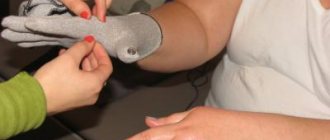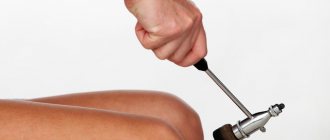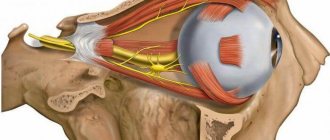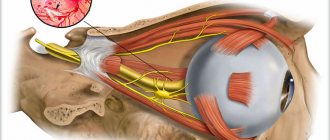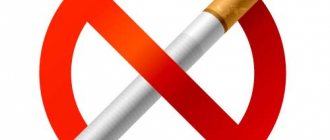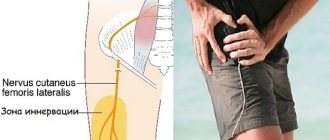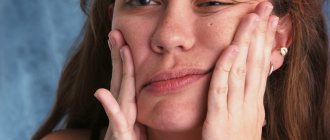Median nerve
[
n.
medianus (PNA, JNA, BNA)] is a long branch of the brachial plexus, innervating the muscles of the forearm and hand, the skin of the palm and palmar surface of the I - III fingers and the radial surface of the IV finger, as well as the skin of their dorsal surface in the area of the distal phalanges.
The anatomy of the Median nerve, the zones and objects of its innervation were studied in detail in the 18th-19th centuries. V. L. Gruber, F. Henle, Krause (K. FT Krause). In the 20th century Borchardt and Vyasmenski (M. Borchardt, Wjasmenski), A. V. Triumphov, A. H. Maksimenkov presented data on the fascicular structure of the nerve, its connections with neighboring nerves, the number and ratio of the nerve fibers that make up the median nerve.
Median nerve neuropathy - what is it?
Median nerve neuropathy is quite common in both children and the elderly.
The pathology leads to pain and impaired finger flexion. Only a neurologist can diagnose neuropathy. To begin with, he conducts an examination and prescribes various examinations. If there is minor damage to the median nerve, it will cause discomfort.
This nerve ending is the largest in the hand and is responsible for all important movements. You should definitely consult a doctor so that he can prescribe drug therapy. If treatment does not bring any results, then surgery is performed.
Causes
The causes of median nerve neuropathy occur due to damage to the nerve ganglia. This can be various injuries and bruises, as well as other pathologies. We must remember that it is best to consult a doctor at the first manifestations.
The following factors provoke damage to the median nerve:
- Various injuries, bruises, fractures, sprains, all this can easily lead to the accumulation of fluid in the tissues, which causes compression of the nerve endings. Pathology may develop if the bone does not heal properly.
- Arthritis. With this disease, soft tissues swell and pinching of the nerve node occurs. If the disease is chronic, it can lead to deformation of the upper limbs.
- The accumulation of fluid in soft tissues occurs against the background of other pathologies. Such as: kidney disease, pregnancy, menopause, nephrosclerosis.
- Median nerve neuropathy can be inherited. If there are close relatives who have this pathology, then there is a high probability of developing the disease.
- Diabetes mellitus can also lead to neuropathy. There is a disruption of the metabolic process and oxygen starvation of tissues, so nerve endings are destroyed.
- Carpal tunnel syndrome occurs because the blood supply is disrupted. Most often, this happens if the hand is in one position for a long time. The syndrome may bother those people who work at a computer with a mouse and keyboard.
- Physical stress on the forearms and hands provokes the development of the disease.
Median nerve neuropathy can even be caused by drinking alcoholic beverages. Everyone knows that alcohol negatively affects all organs. If you take it for a long time, it causes severe harm to the nerve endings.
Poisoning the body with chemicals also leads to the development of neuritis. It is known that intoxication causes a strong blow to the nerves. Infectious diseases HIV, herpes, diphtheria, provoke neuropathy of the median nerve ganglion.
Symptoms
Median nerve neuritis refers to a disease of the nervous system. At the initial stage of development of the pathology, the patient may feel that it becomes difficult for him to squeeze some fingers on his hand. The pain can be of a burning nature and on a constant basis.
The following symptoms are observed with median nerve neuropathy:
- Intense pain that covers the forearm and moves to the fingers;
- It becomes difficult to clench your hand into a fist;
- Muscle weakness;
- Numbness of the limbs;
- Loss of sensitivity in fingers and palms;
- Tingling in the forearm area.
If the above symptoms occur, you should consult a doctor. If the disease is neglected, there may be irreversible complications. The attending physician will be able to refer you for a comprehensive examination and prescribe effective treatment.
You should not ignore the signs of the development of pathology, as this will ultimately lead to a complete loss of finger mobility.
Diagnostics
When visiting a doctor, he first performs a neurological examination. This happens in such a way that the patient must try to clench his hand into a fist. If he can't bend some of his fingers, he most likely has median nerve neuropathy. Treatment of pathology should be aimed at the affected area.
Electroneuromyography is also performed to understand the speed at which impulses travel along the nerve ending. This diagnostic method makes it possible to find out exactly where the damaged nerve is located. A computed tomography scan and x-ray of the hand will help the doctor know what treatment is best to prescribe.
The specialist may refer you for an MRI to see the condition of the soft tissues. If the doctor prescribes treatment and it does not bring a positive result, then surgery will most likely be used. In order not to start the disease, it is necessary to contact a medical facility at the first manifestations.
Treatment
Treatment of median nerve neuropathy is primarily carried out by qualified specialists. Hematoma may be drained if the nerve ending is damaged if medications do not help. The operation is carried out by opening the affected area and washing with an antiseptic.
Tumor removal may be indicated if there is severe pressure on the nerves. Before surgery, it is imperative to consult an oncologist in order to exclude malignant neoplasms.
Various injuries are treated by restoring bones, ligaments, tendons and relieving swelling in the injured area. If a patient suffers from diabetes, then he constantly needs to monitor his blood sugar levels. This is necessary in order to avoid complications of diabetic angiopathy and polyneuropathy.
Drug therapy is also required to eliminate the inflammatory process and pain. You should not self-medicate, as this can lead to consequences. It is best to consult a doctor at the first manifestations of neuritis.
The following medications are used:
- Non-steroidal anti-inflammatory drugs. Diclofenac helps relieve inflammation and relieve pain. The drug can be purchased in the form of ointments, injections, tablets. Most often, a drug is prescribed for intramuscular administration. The drug must be used carefully as there are contraindications. To ensure that NSAIDs do not cause harm to the mucous membranes, it is recommended to use the products after meals. Ibuprofen reduces inflammation and is considered a pain reliever. Most often used in the form of gels and ointments. It is worth paying attention to contraindications and side effects.
- Glucocorticosteroid drugs are often used together with non-steroidal anti-inflammatory drugs. Prednisolone helps cope with the inflammatory process and constricts blood vessels. Most often, the drug is injected into the affected area. There are also contraindications; injections should not be used for infections in the affected area.
- The blockade is used when it is necessary to quickly relieve severe pain. This method brings positive results, but it should only be carried out by an experienced specialist. As a rule, about two blockades are done and this is enough. Novocaine has little toxicity and does not last long. Contraindication is intolerance to the component. Marcaine lasts much longer than other painkillers, but has greater toxicity.
- Agents that have a restorative effect on nerve endings. Milgamma helps relieve inflammation and pain. It also contains B vitamins and lidocaine. Restores nerve nodes and is used initially in the form of injections, and then proceeds to treatment with tablets. Neuromidin improves the patency of nerve fibers. There are also contraindications and side effects, so the drug must be used with caution.
Median nerve neuropathy can be treated not only with medications, but also in other ways. Massage procedures bring positive results. To do this, the massage is done first from the cervical and thoracic spine. Then you need to gently rub and knead your forearms and hands. As a rule, a course of complete therapy is carried out about twenty procedures.
Complications
If you ignore the symptoms of median nerve neuropathy, serious complications can arise. It will no longer be possible to correct the changes that have occurred.
There is a loss of mobility in the hands, the muscles weaken, and the fingers may practically not move. Without a certain load, joints become thinner and arthritis occurs.
The place where the nerve ending was compressed hurts constantly.
If the disease has been completely advanced, then there is a complete cessation of finger mobility. The patient cannot write, eat, or fasten his belt independently.
In order to avoid such unpleasant complications, it is necessary to consult a doctor in a timely manner. He will prescribe a comprehensive examination and effective treatment.
Everyone should know that the sooner treatment is started, the less consequences there will be.
Prevention
In order to avoid median nerve neuropathy, you must adhere to some recommendations. The diet must be balanced to contain all the necessary vitamins and minerals. Lead a healthy lifestyle and walk more in the fresh air.
If you work constantly at the computer, then you need to hold the mouse in different hands more often and take breaks. Try to do exercises every morning and avoid stressful situations. It is best to take a complex of vitamins for prevention. Get examined once a year at a medical facility.
Also read about ulnar or femoral nerve neuropathy.
Median nerve neuropathy responds well to treatment in its early stages. If you consult a doctor in time, you can avoid serious consequences. If the disease is advanced, there may be impaired mobility of the fingers. Treatment should be prescribed only by the attending physician, otherwise there may be complications. It is best to seek help from a medical facility at the first symptoms.
Source: //nevrology.net/sindromy-i-zabolevaniya/perifericheskoj-nervnoj-sistemy/nejropatiya/nevropatiya-sredinnogo-nerva.html
Features of training rehabilitation
When a person has a stroke, cerebral circulation is disrupted, leading to serious impairment of motor ability.
Common consequences include joint contracture, muscle atrophy and spasticity, paresis and paralysis.
The brain loses the ability to coordinate and control joints and muscles. Only special events can gradually restore lost functions.
The rehabilitation scheme is strictly individual, complex, the most important element of which is exercise therapy.
Special simulators provide mechanotherapy. Essentially, these are devices, instruments and appliances that provide targeted physical activity to the joints and muscle tissues affected by a stroke. They solve the following problems:
- Normalization of muscle tone. Post-stroke muscle hypertonicity impairs the activity and coordination of joint movement. Exercise machines allow you to restore normal muscle tone, achieve the desired sequence of movement, restore biological feedback and neuromuscular control, and eliminate pain during movement.
- Improving blood circulation and trophism. Controlled physical activity normalizes the supply of oxygen to brain tissue, normalizes tissue metabolism, which has a positive effect on the innervation of motor centers.
- Overcoming the psychological factor. After prolonged immobility, a person develops a psychological barrier, the fear of loss of mobility. He simply loses confidence in his abilities. Exercise machines allow the victim to again learn to control his muscles, walk, load his limbs, and hold objects in his hands.
Important! The advantage of simulators is the possibility of targeted loading of muscles and changing the point of application of the load, regulating the load and amplitude of movement. During the rehabilitation period, they help to gradually restore the relationship of the brain with the limbs and other muscular systems and restore physical fitness.
Median nerve neuropathy and how the average person can recognize it
The disease neuropathy of the median nerve is often encountered in the practice of a neurologist. Proper movement of the arms and hands depends on the health of the radial, median, and ulnar nerves. The slightest damage to them leads to problems and discomfort. Disturbance in the functioning of nerves is accompanied by a disease called in neurology neuropathy of the upper extremities.
General information
According to human anatomy, the median nerve (from the Latin nervus medianus) is the largest in the brachial plexus. It innervates almost the entire upper limb.
The median nerve responds:
- for flexing the muscles of the forearm;
- for motor activity of the thumb, middle and index finger;
- wrist sensitivity;
- abduction and adduction of the left and right hand.
Causes of defeat
Neuropathy of the median nerve is considered to be damage to a section of the median nerve. The cause of the disease is often swelling of the soft tissues due to any mechanical damage or disease.
Damage to the median nerve is caused by the following factors:
- Injuries. Sprains, dislocations, fractures, bruises provoke dilation of blood vessels, fluid accumulates in the soft tissues. The nerve is compressed. The situation can be aggravated by bone damage and improper fusion.
- Arthritis. With this disease, the soft tissues of the body swell and pressure occurs on the nerve. Chronic disease often leads to disastrous results, hand deformation. This occurs due to the fact that the tissues begin to wear away, and the surfaces of the joints undergo fusion, exposing the bone.
- Fluid in soft tissues also accumulates due to other diseases, such as: nephrosclerosis, problems with the kidneys, problems with thyroid hormones, pregnancy, menopause, ischemia, as well as some other pathologies.
- Genetic predisposition. If parents or grandparents suffered from joint problems, then sometimes this is inherited.
- The risk group includes people suffering from diabetes. Due to impaired glucose metabolism and oxygen starvation of cells, nerve fibers are destroyed.
- Carpal tunnel syndrome. This disease belongs to diseases of the peripheral nervous system. Blood circulation is disrupted when the hands do not change their position while in a static state. This causes compression of the nerve. The syndrome often develops during prolonged use of the mouse and keyboard.
- Due to certain activities, compression-ischemic neuropathy of the median nerve occurs. It is associated with long-term macrotrauma to the nerve. This is facilitated, for example, by heavy physical labor with overload of the forearm and hand.
External causes of neuropathy of the median nerve of the arm also include:
- intoxication of the body;
- alcohol abuse;
- past infections (for example, HIV, diphtheria, herpes).
Classification
Neuropathy (neuropathy) is a disease characterized by damage to nerve fibers. When only one nerve becomes inflamed due to an illness, this is called mononeuropathy; two or more are called polyneuropathy.
Neuropathy is divided into 3 forms:
- diabetic (when nerve fibers and blood vessels are damaged due to high blood sugar);
- toxic (infectious diseases, chemicals - all this affects the condition of nerve fibers);
- post-traumatic (this type of illness develops after damage to the myelin sheath of the nerve. Most often the sciatic, ulnar and radial nerves are injured);
Neuritis develops under similar conditions as median nerve neuropathy, but this disease is characterized by inflammation.
Based on the type and location of the pathology development zone, neuropathy has the following classification:
- radial nerve neuropathy;
- damage to the lower extremities;
- sciatic nerve neuropathy;
- ulnar nerve neuropathy;
- median nerve;
- peroneal nerve;
- facial nerve;
- trigeminal nerve;
- tunnel neuropathy;
- sensorimotor neuropathy.
N medianus approaches the hand through the carpal tunnel. Here it innervates the muscles responsible for the opposition and abduction of the thumb, the lumbrical muscles, and the muscles that flex the finger. Its branches also supply nerve fibers to the wrist joint.
Median nerve neuropathy is associated with carpal tunnel syndrome, as the disease develops from constant compression in the wrist area.
From a surgical point of view, lesions of the median nerve are divided into open and closed. Open ones, in addition to the nerve, affect the tendons, blood vessels and muscles of the patient. Closed injuries include bruising, squeezing or spraining. Damage to the median nerve can develop along with plexopathy—damage to the cervical or brachial nerve plexuses.
Complex lesions (eg, trauma) often extend to the ulnar nerve. Cubital syndrome occurs (when the nerve of the cubital canal is compressed).
Symptoms of the disease
Neuropathy of the median nerve of the hand (or neuritis) refers to diseases of the nervous system. When the disease begins to develop, the patient experiences difficulty clenching the first, second and third fingers of the hand into a fist. It is also difficult for him to simply move the second and third fingers. Other symptoms:
- Inability to oppose the thumb to the rest.
- Poor sensitivity in the palm and fingers.
- The appearance of the "monkey's paw". This is due to the fact that atrophy of the hand muscles occurs. As a result of this, the first finger of the hand is installed with the second in the same plane.
- The main symptom is acute pain, manifested in the area from the forearm to the fingers of the affected hand.
- Numbness of the hand, muscle weakness, tingling in the forearm.
Prognosis and prevention
If there is no threat to health in the form of infections or injuries, sufficient attention should be paid to the prevention of neuropathy of the upper extremities, namely:
- Physical exercises for the arms. They include a simple warm-up for the hands.
- It is important to take breaks when working at a computer. When working with a computer mouse, you need to hold it in different hands alternately.
- Taking the vitamin is beneficial, as well as strengthening the overall health of a person. This reduces the risk of diseases of the neurology of the extremities.
It should be remembered that timely treatment begins to guarantee a good prognosis for future hand function. Restoring motor activity should begin as early as possible. Ignoring therapy or improper self-medication often causes disastrous consequences.
Source: //nervivporyadke.ru/
Source: //zen.yandex.ru/media/id/595f61ded7d0a69b431e48f9/5db12a89aad43600b241ad95
Clinical picture
The disease manifests itself as pain along the back of the lower leg, weakness in the leg for several months or years. Numbness gradually appears on the back of the lower leg, in the area of the sole. Over the course of several years, weakness in the toes increases, up to a complete lack of movement in them. Less often, patients are bothered by a burning sensation, a “tingling” feeling in the sole area.
An objective examination of the patient reveals pain during palpation of the tibial nerve from the foot to the popliteal fossa (50%), hypoesthesia of the posterior surface of the leg, plantar and lateral part of the foot (60%). Weakness of the plantar flexors of the foot and toes (80%), weakness of internal rotation of the foot, and muscle atrophy in the lower leg and foot (70%) are noted. Walking “on tiptoes” is difficult or impossible (50%).
Median nerve neuropathy
Median nerve neuropathy
- defeat n. medianus on any part of it, leading to pain and swelling of the hand, sensitivity disorder of the palmar surface and the first 3.5 fingers, impaired flexion of these fingers and opposition of the thumb.
Diagnosis is carried out by a neurologist based on the results of a neurological examination and electroneuromyography; Additionally, musculoskeletal structures are examined using radiography, ultrasound and tomography. Treatment includes painkillers, anti-inflammatory, neurometabolic, vascular pharmaceuticals, exercise therapy, physiotherapy, and massage.
Surgical interventions are performed according to indications.
Median nerve neuropathy is quite common. The main contingent of patients are young and middle-aged people.
The most common places of damage to the median nerve correspond to the areas of its greatest vulnerability - anatomical tunnels, in which compression (compression) of the nerve trunk is possible with the development of the so-called. tunnel syndrome.
The most common tunnel syndrome is n. medianus is carpal tunnel syndrome - compression of the nerve as it passes to the hand. The average incidence in the population is 2-3%.
The second most common site of damage to the median nerve is its section in the upper part of the forearm, running between the muscle bundles of the pronator teres. This neuropathy is called “pronator teres syndrome.” In the lower third of the shoulder n.
medianus may be compressed by an abnormal process of the humerus or Struther's ligament. Its lesion in this place is called Struzer's band syndrome, or supracondylar process syndrome of the shoulder.
In the literature you can also find a synonymous name - Coulomb-Lord-Bedosier syndrome, which includes the names of the co-authors who first described this syndrome in 1963.
Severe bruise of the hand: how to treat
The following cases mainly provoke an unpleasant situation:
- Hit;
- Hand clamping;
- A fall;
- road accident;
- Injury as a result of performing sports exercises.
A bruise is damage to soft tissues and skin. It may be accompanied by a violation of the integrity of ligaments and bones. A minor bruise does not cause much discomfort. However, bruising may occur. If the injury is severe, a large hematoma will appear. Pulsation and pain may also occur during movement. In this case, you should definitely visit the emergency room. There you will be examined for bone cracks, tendon ruptures, fractures, and dislocations.
